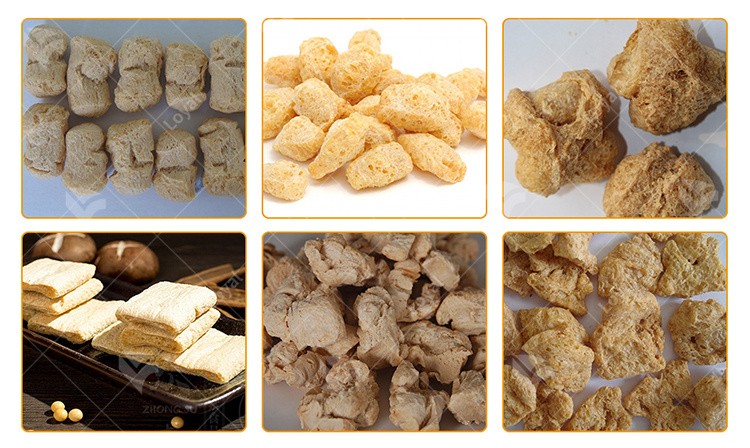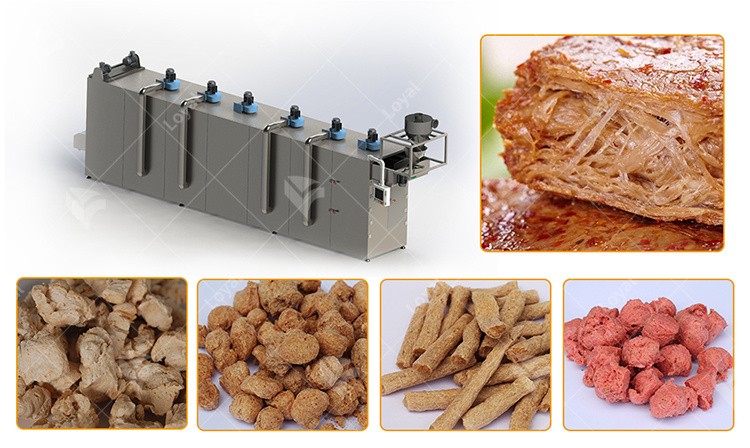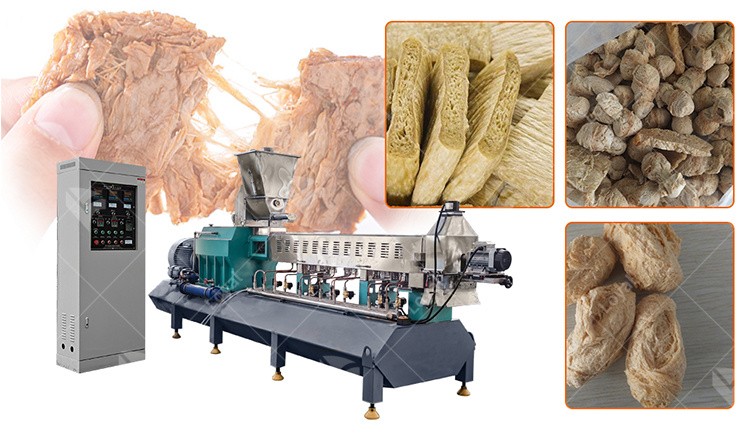
- Shandong Loyal Industrial Co.,Ltd.
- Macaroni Production Machine Instant Noodle Machine Biscuit Making Machine
Home> Company News> How To Make Soya Meat Protein Automatically?

How To Make Soya Meat Protein Automatically?
2023-03-16 11:07:26Introduction of Soya Meat Protein Making Machine:
Soya meat protein making machines, also known as soy protein extruders, are used to create textured vegetable protein (TVP) from soybeans. TVP is a meat substitute made from soy flour that has been extruded into various shapes and sizes, and it can be used in a wide range of food products, such as vegetarian burgers, sausages, and meatballs.The process of making TVP involves mixing soy flour with water, and then using an extruder to force the mixture through a die to create a protein-rich meat-like texture. The extruded TVP is then dried and packaged for sale or further processing.Soya meat protein making machines come in various sizes and capacities, ranging from small-scale tabletop models to large industrial machines capable of producing several tons of TVP per day. They are often used by food manufacturers, restaurants, and catering services to create vegetarian and vegan meat alternatives that are low in fat, high in protein, and affordable.

Flow Chart of Soya Meat Protein Processing Line:
- Mixing --- 2. Screw Conveyor --- 3. Extruding --- 4. Air Conveyor --- 5. Drying --- 6. Cooling Conveyor
The Equipment Using In The Soya Meat Protein Making Machine:
1.Mixer: The mixer is used to mix the soybean slurry with other ingredients, such as salt, spices, and flavors, to improve the taste of the final product.
2.Extruder: The extruder is the heart of the soya meat protein making machine. It forces the soybean slurry through a die, which gives the TVP its unique shape and texture. The extruder can be single-screw or twin-screw, and its size and capacity depend on the production requirements.
3.Cutter: The cutter is used to cut the extruded TVP into the desired shape and size, such as flakes, chunks, or mince.
4.Dryer: The dryer removes the moisture from the TVP to increase its shelf life and make it easier to store and transport. The dryer can be a hot air oven, a belt dryer, or a microwave dryer, depending on the production needs.
5.Packaging Equipment: The packaging equipment is used to pack the final product into bags, cartons, or other containers, and to label them with the necessary information, such as the product name, weight, and expiry date.
Overall, these equipment work together in a soya meat protein making machine to produce TVP, which is a nutritious, versatile, and sustainable meat alternative.
Feature Of Automatically Soya Meat Protein Machines:
1.High Production Capacity: Automated soya meat protein machines have high production capacity and can produce a large quantity of TVP in a short period.
2.Consistency: Automated soya meat protein machines ensure consistency in the size, shape, and texture of the TVP.
3.Customization: Automated soya meat protein machines can be customized to produce TVP in different shapes, sizes, and flavors.
4.Efficiency: Automated soya meat protein machines are highly efficient and can operate continuously without the need for frequent maintenance or downtime.
5.Food Safety: Automated soya meat protein machines are designed to meet food safety standards and regulations.
6.User-Friendly: Automated soya meat protein machines are user-friendly and easy to operate.
The Parameter Of Soya Meat Protein Process Line
|
Model |
Installed Power (Kw) |
Power Consumption (Kw) |
Output (Kg/h) |
Size(L*W*H) (Mm) |
|
LY65 |
100kw |
80kw |
180-220kg/h |
19000*1200*1800mm |
|
LY70 |
109kw |
93kw |
250-300kg/h |
20000*1200*2200mm |
|
LY85 |
156kw |
125kw |
300-500kg/h |
21000*1200*2200mm |

Applications Of Automatic Soya Meat Protein Production Line:
1.Meat Alternatives: The most common application of automatic soya meat protein production lines is in the production of meat alternatives. The TVP produced by these lines can be used to make vegetarian and vegan burgers, sausages, meatballs, and other meat-like products.
2.Snack Foods: Soya meat protein production lines can also be used to produce a variety of snack foods, such as flavored soya meat protein sticks, chips, and bites.
3.Pet Food: The high protein content of TVP makes it an ideal ingredient for pet food. Soya meat protein production lines can be used to produce TVP for use in pet food, which is a sustainable and nutritious alternative to meat-based pet food.
4.Ready-to-eat Meals: TVP produced by soya meat protein production lines can also be used as an ingredient in ready-to-eat meals, such as stews, curries, and pasta sauces.
5.Food Ingredients: TVP can also be used as an ingredient in other food products, such as baked goods, breakfast cereals, and snacks.
Overall, automatic soya meat protein production lines have a wide range of applications in the food industry and are an essential tool for producing sustainable, nutritious, and delicious meat alternatives and other food products.

 Commercial Japanese Panko Bread Crumb Grinder Machine
Commercial Japanese Panko Bread Crumb Grinder Machine Japanese Bread Crumbs Processing Line
Japanese Bread Crumbs Processing Line Automatic Cookies Making Machines
Automatic Cookies Making Machines Fully Automatic Biscuit Making Machines
Fully Automatic Biscuit Making Machines